22 Authentic German Beef Dishes That Define Hearty Cuisine
German beef dishes represent a culinary tradition deeply rooted in hearty, flavorful cooking techniques that have evolved through generations of passionate home cooks and professional chefs.
Robust flavors and meticulous preparation characterize these delectable meat-based creations that showcase Germany's rich gastronomic heritage.
Regional variations highlight unique cooking methods and local ingredient preferences, transforming simple beef into extraordinary culinary experiences.
Traditional recipes often incorporate complex marinades, slow-cooking techniques, and carefully selected spices that enhance the natural richness of beef.
Sophisticated yet comforting, these dishes reflect a cultural commitment to quality ingredients and time-honored cooking practices.
Cultural influences from neighboring European countries have subtly shaped and refined German beef cuisine over centuries.
The combination of rustic techniques and refined culinary skills makes these dishes both approachable and sophisticated.
Your appetite will be thoroughly intrigued by these 22 signature German beef dishes that promise an authentic taste of traditional German cooking:
Signature German Beef Dishes Full of Tradition
German beef recipes combine hearty cuts with rich sauces and seasonal vegetables. From sauerbraten to goulash, these dishes are true tastes of the homeland.
Rinderbrust
Brisket is a massive beef cut from a cow's breast with challenging connective tissues that demand slow, low-heat cooking to transform tough muscle into meltingly tender meat.
Originating from American, English, and German butchery traditions, this primal cut contains two distinct muscles: the leaner "flat" and fattier "point" sections.
German butchers call it rinderbrust and recognize its complex muscle structure.
Beef enthusiasts prize brisket for its deep flavor and potential to become incredibly soft after long braising or smoking.
Barbecue masters often spend hours carefully preparing this cut to achieve perfect texture and rich taste.
Southern United States cooking techniques have popularized brisket as a centerpiece of smoky, rich meat preparations.
Jewish cuisine also features brisket as a traditional holiday dish with roots in Eastern European cooking methods.
Low and slow cooking techniques help break down collagen, transforming this tough cut into a succulent meal.
Filet
Beef tenderloin embodies supreme tenderness from a rarely used muscle near a cow's backbone, spanning short loin and sirloin sections.
Meat experts consider this cut among the most expensive beef selections worldwide due to its exceptional softness and minimal muscle movement.
Premium restaurants frequently prepare tenderloin through high-heat methods like grilling or broiling to maximize its natural qualities.
American, French, German, Brazilian, and Korean butchery traditions recognize this specific cut's unique characteristics.
Chefs select this portion for its unparalleled texture and minimal connective tissue.
Restaurant patrons value its melt-in-mouth sensation and elegant presentation.
Fine dining establishments typically slice tenderloin into premium steaks like filet mignon.
Sophisticated meat lovers consistently rank this cut as a top-tier beef selection for its remarkable eating experience.
Zwiebelrostbraten
Zwiebelrostbraten stands as a classic German beef dish featuring caramelized onion-topped sirloin steak with robust flavor and crispy texture.
Bavarian and Viennese restaurants showcase this hearty meal with carefully prepared beef seared to golden perfection.
Restaurant chefs meticulously slice onions into thin rings and coat them in seasoned flour before frying until deep brown and crisp.
Butter and oil create a rich base for pan-frying the seasoned sirloin steak with a delicate paprika and flour crust.
Dijon mustard and beef stock transform the pan drippings into a luscious cream sauce that complements the meat's savory profile.
Salt and pepper enhance the steak's natural flavors during preparation.
Careful cooking technique ensures each ingredient maintains its distinctive taste and texture.
Traditional preparation methods highlight the simple yet elegant nature of this beloved German meat dish.
Rouladen
Rouladen are savory German beef rolls packed with flavor and culinary tradition.
Thin beef steaks get pounded, coated with sharp German mustard, and rolled around classic fillings like bacon and pickles.
Regional variations might include extra ingredients such as carrots or onions.
Cooks carefully secure the rolls with toothpicks before cooking them slowly to ensure maximum tenderness.
German kitchens typically serve rouladen with a rich, creamy sauce that complements the meat's robust taste.
Each roll delivers a perfect balance of smoky, tangy, and meaty flavors.
Traditional German restaurants and home kitchens consider rouladen a beloved comfort food staple.
Rindergulasch
Rindsgoulasch transforms classic Hungarian beef stew into an Austrian culinary masterpiece featuring slow-cooked beef simmered in a rich, dark gravy with complex spices.
German and Austrian kitchens embrace this hearty dish as a winter comfort food with deep flavor profiles.
Beef becomes incredibly tender through hours of braising in liquid like stock, water, or red wine.
Traditional ingredients include onions, garlic, powdered paprika, tomato paste, caraway seeds, marjoram, vinegar, salt, and pepper.
Spice combinations vary between family recipes, creating unique taste experiences.
Regional differences emerge in ingredient preparation methods and cooking techniques.
Viennese cuisine considers this stew a signature meal.
Restaurant and home cooks pride themselves on perfecting their personal goulash approach.
Sauerbraten
Sauerbraten are signature German pot roasts that magically transform tough beef cuts into meltingly tender masterpieces through an intricate wine-vinegar marinade.
Beef chuck or bottom round absorbs complex flavors during multiple days of soaking in red wine, vinegar, and aromatic spices.
Traditional preparation requires patient marinating and slow braising to break down muscle fibers and develop rich, tangy characteristics.
German home kitchens celebrate this dish by creating a signature brown gravy called einbrenne from the concentrated cooking liquid.
Spices like cloves, juniper berries, and peppercorns contribute deep, nuanced flavor profiles to the meat.
Regional variations sometimes include adding crushed gingersnap cookies to thicken and sweeten the sauce.
Accompanying sides typically feature spatzle, potato dumplings, or boiled potatoes with braised red cabbage.
Rostbraten
Rostbraten defines a premium beef cut from a cow's rump or loin, prized for its lean and tender texture in German-speaking regions.
German and Austrian kitchens transform this select cut through precise cooking techniques like pan-searing, oven roasting, or slow simmering with rich onion broths.
Professional butchers carefully select sirloin or rump sections, ensuring optimal meat quality for traditional preparation methods.
German households typically serve rostbraten with robust side dishes like roasted potatoes or hearty vegetable accompaniments.
Regional variations influence cooking styles, with some cooks preferring quick high-heat searing while others opt for slower braising techniques.
Restaurant menus often feature rostbraten as a signature beef dish, highlighting its cultural significance in Germanic cuisine.
Western European meat enthusiasts consider rostbraten a benchmark for exceptional beef preparation.
Gaisburger Marsch
Gaisburger marsch is a hearty German beef stew from Swabia, featuring tender meat simmered in a rich broth with potatoes, carrots, and spatzle.
German military folklore suggests officer candidates would march to local restaurants for this comforting meal, giving the dish its unique name.
Roasted onions, parsley, and chives crown the stew, adding layers of flavor and texture.
Regional stories trace its origins to family traditions in Gaisburg, with some claiming imprisoned locals' wives created the recipe.
Military connections and local culinary heritage intertwine in this classic German comfort food.
Traditional preparation involves carefully cutting beef into bite-sized pieces and simmering them slowly.
Regional ingredients and cooking techniques make the dish a true representation of Swabian cuisine.
Warm, satisfying flavors define this beloved German stew.
Hesse
Beef shank is a robust, muscular cut from a cow's leg, prized for its intense flavor and challenging texture derived from constant muscle movement.
Loaded with connective tissue, this meat transforms through slow braising methods that break down tough fibers into meltingly tender results.
German, American, and Brazilian butchers recognize front and hind shanks as uniquely demanding cuts requiring patient cooking techniques.
Marrow-rich bones within the shank make it ideal for creating deeply flavored stocks and broths.
Professional chefs value this cut for its complex taste profile and ability to absorb seasonings during extended cooking processes.
Soups and stews benefit most from shank's rich protein and collagen content.
Traditional European and Latin American cuisines frequently feature shank in classic comfort dishes.
Slow-cooked shank meat offers exceptional depth and richness unmatched by more tender beef cuts.
Pfefferpotthast
Pfefferpotthast embodies Westphalia's robust meat stew tradition, featuring tender beef simmered in a deeply seasoned broth infused with complex spices like cloves, juniper berries, and bay leaves.
Westphalian cooks carefully brown meat pieces in lard before slowly cooking them with onions and soup vegetables, creating a rich flavor profile.
Pumpernickel rye bread traditionally thickens the broth, adding depth and traditional texture to the dish.
Pepper and salt enhance the meat's natural flavors, making each bite intensely satisfying.
Germans typically serve this warming stew with pickled gherkins, salt potatoes, and beetroots for a complete meal.
Cold autumn and winter days inspire home cooks to prepare this hearty regional specialty.
Regional ingredients and slow-cooking techniques transform simple beef into a comforting masterpiece.
German beer perfectly complements the stew's robust character.
Hufte
Hufte is a premium German beef cut from the cow's hip area, offering a perfect balance between tenderness and robust flavor.
Located on the back portion of the cow, this moderately exercised muscle delivers a rich, beefy taste that stands out in German butchery.
Chefs prize hufte for its intermediate texture, sitting between the ultra-tender fillet and tougher shank cuts.
Roasting works best when searing first to seal in juices before finishing in the oven.
Grilling and pan-searing also produce excellent results for hufte steaks.
Marinating can enhance the meat's natural taste profile.
Proper preparation transforms hufte into a succulent, memorable dish.
Seasoned techniques ensure maximum enjoyment of this distinctive beef cut.
Oberschale
Oberschale is a lean, fine-grained beef cut from the upper hind leg of a cow, prized for its well-defined flavor profile.
German butchers select this muscle area for its moderate exercise level, which contributes to its distinctive meat characteristics.
Moderate exercise gives the cut a robust beef taste that stands out in various culinary preparations.
Chefs recommend slow cooking methods like braising or roasting to preserve its moisture and tenderness.
Marinating or wrapping with bacon helps prevent the meat from becoming dry during cooking.
Quick searing works best when preparing steaks to maintain juiciness and flavor.
Root vegetables and robust herbs like rosemary and thyme complement its natural taste perfectly.
Classic rich sauces enhance the meat's deep, authentic beef flavor.
Hals
Hals rind is a tough, muscular beef neck cut prized in German butchery for its intense flavor and challenging preparation method.
German butchers carefully select this meat from the upper cow section near the head, recognizing its dense connective tissue and complex muscle structure.
Professional meat preparers recommend slow-cooking techniques like braising or stewing to break down its tough fibers and transform the meat into a tender, rich dish.
Low and slow heat gradually softens the muscular tissues, releasing deep beef flavors and creating a meltingly soft texture.
Skilled chefs often marinate the meat beforehand to enhance its natural taste and improve tenderness.
Traditional German recipes typically incorporate this cut into hearty stews, pot roasts, and classic beef dishes.
Butchers value hals rind for its affordability and potential to create intensely flavorful meals when prepared with patience and technique.
Flanke
Flanke is a lean, muscular beef cut from a cow's abdominal region, characterized by its distinctive grain pattern and well-developed muscle structure.
German butchers prize this long, flat slice for its intense flavor and challenging texture.
Positioned below the loin and rib, flanke serves a critical role in bovine movement and muscle development.
Chefs typically prepare this cut through slow-cooking techniques like braising to soften its tough fibers.
Marinating helps tenderize the meat and introduces complex flavor profiles.
Acidic marinades work especially well to break down muscle proteins.
Grilling or broiling after marination can enhance its natural taste.
Slicing against the grain remains crucial for maximizing meat tenderness.
Hochrippe
Hochrippe represents a prized German beef cut from the upper rib section of cattle, characterized by exceptional marbling and rich flavor.
German butchers carefully select this forequarter section situated near the neck, delivering a supremely tender meat with significant intramuscular fat.
Professional meat processors appreciate its robust texture and deep taste profile, which makes it ideal for roasting and slow-cooking methods.
High-quality beef from this section provides superior moisture and intense beef characteristics that home cooks and professional kitchens value.
Meat enthusiasts recognize hochrippe as a premium cut with exceptional tenderness and complex flavor notes.
German culinary traditions celebrate this specific beef section for its superior eating experience.
Roasting techniques enhance its natural fat content and create a succulent dining experience.
Professional butchers recommend slow-cooking methods to maximize its inherent flavor potential.
Querrippe
Querrippe is a German beef cut prized for its complex flavor profile and tender texture from the chuck region.
Butchers identify this cross rib portion extending from the lower chuck to the brisket with distinctive marbling and connective tissue.
Fat layers and the embedded rib bone contribute robust meaty depth during slow cooking processes.
Braising and stewing methods transform querrippe into meltingly soft meat dishes with intense beef characteristics.
German culinary traditions favor this cut for its rich, hearty composition and ability to absorb seasonings deeply.
Muscle and bone combination ensures maximum flavor development during extended cooking times.
Slow preparation techniques break down tough muscle fibers, creating succulent meat presentations.
Exceptional for pot roasts and hearty winter meals, querrippe represents a classic German butchery technique.
Schulter
Schulter is a German beef cut from the cow's shoulder, renowned for its intense beefy flavor and unique muscle composition resulting from constant leg movement.
Characterized by significant connective tissue, this tough cut transforms beautifully through slow-cooking techniques like braising and stewing.
Multiple muscles within schulter become remarkably tender when prepared methodically, breaking down complex tissues during extended cooking periods.
Rich marbling throughout the meat contributes substantial depth and richness to dishes.
Searing before slow cooking enhances flavor through caramelization, creating additional taste complexity.
German culinary traditions often pair schulter with robust ingredients like root vegetables and hearty herbs.
Braising in flavorful liquids such as wine or beef broth further amplifies its natural characteristics.
Professional butchers recommend selecting schulter for dishes requiring extended, low-temperature cooking methods.
Unterschale
Unterschale is a lean, flavorful beef cut from a cow's inner thigh muscle that offers a perfect balance between tenderness and rich taste.
German butchers prize this meat for its smooth texture and moderate exercise-developed character.
Slow cooking transforms unterschale into a melt-in-your-mouth delicacy that absorbs surrounding spices and broths beautifully.
Chefs recommend slicing this cut against the grain to maximize its softness and eating experience.
Braising works especially well with unterschale, creating deep, complex flavor profiles.
Professional butchers consider this cut versatile for multiple cooking methods.
German cuisine frequently features unterschale in traditional stews and hearty meat dishes.
Restaurant kitchens value this cut for its consistent quality and adaptable preparation techniques.
Nuss
Nuss is a tender beef cut from the inner thigh of a cow, characterized by its rounded shape and minimal muscle strain.
German butchers prize this meat for its fine-grained texture and moderate beef flavor, making it ideal for quick cooking methods like grilling or pan-searing.
Its location deep within the leg muscles ensures a consistently soft consistency that chefs appreciate for roasting and cubing.
Quick basting helps preserve the meat's natural juiciness during cooking.
Classic herbs such as rosemary, thyme, and parsley complement its mild taste beautifully.
Nuss performs exceptionally well in dishes requiring tender beef strips or cubes.
Roasting requires careful attention to maintain its delicate moisture.
Spannrippe
Spannrippe is a prized German beef cut from the lower rib section near a cow's belly, known for its lean muscles and intense beefy flavor.
Butchers select this forequarter section for its rich, robust taste developed through muscle movement.
Connective tissues make spannrippe naturally tough, requiring slow-cooking methods like braising or stewing.
Chefs typically brown the meat first to enhance its deep flavor profile.
Root vegetables and aromatic herbs perfectly complement its meaty characteristics.
Slow cooking breaks down collagen, transforming the dense cut into a tender, flavorful dish.
Wine or rich broths further intensify its natural taste.
German butchery techniques ensure this cut remains a premium choice for hearty meat preparations.
Dunnung
Dunnung represents a distinctive set of beef cuts from the lower belly and flank of cattle, characterized by well-developed muscles from constant movement and rich connective tissue.
German butchers prize these cuts for their deep, intense beef flavor that emerges from the muscle's consistent exercise.
Prolonged low-temperature cooking transforms the initially tough meat into a tender, flavorful dish by melting collagen and breaking down connective tissues.
Preliminary browning further enhances the meat's robust taste profile and creates additional depth in the cooking liquid.
These cuts require careful preparation to maximize their potential and achieve a succulent final result.
Professional butchers select dunnung for specific recipes that benefit from its unique texture and intense flavor characteristics.
Slow braising or extended roasting methods work best for rendering these muscular sections into a delectable meal.
Professional meat preparation techniques ensure dunnung becomes a memorable culinary experience with proper cooking methods.
Matrosenfleisch
Matrosenfleisch is a hearty Bremen specialty featuring beef tenderloin wrapped in crispy bacon and cooked with a rich, creamy sauce.
German sailors traditionally prepared this robust dish using simple ingredients like beef, bacon, and aromatic herbs.
Chefs carefully season beef steaks with salt and pepper before wrapping them in smoky bacon strips.
Cooks dredge one side of the meat in flour and quickly brown the steaks in butter until golden.
Onions and parsley are then sautéed in the same pan, creating a flavorful base for the sauce.
Additional flour helps thicken the mixture while beef stock and sour cream add depth and richness.
Capers and lemon peel provide a tangy counterpoint to the meat's savory profile.
Marjoram rounds out the dish with its subtle, earthy undertones.
What Are German Beef Dishes Most Commonly Served With?
German beef dishes are traditionally accompanied by hearty, comforting sides that complement the rich flavors of the meat. Common accompaniments include:
Is Beef More Popular Than Pork in Germany?
No, pork remains the most popular and widely consumed meat in Germany, deeply rooted in traditional cuisine.
Iconic German pork dishes include Schweinshaxe (pork knuckle), Bratwurst, and Schnitzel made from pork.
However, beef is also valued and used extensively, especially in hearty stews (Rindergulasch), roasts, and specialty dishes like Sauerbraten.
While pork dominates overall consumption, beef holds an important place, particularly in certain regional recipes and celebrations.

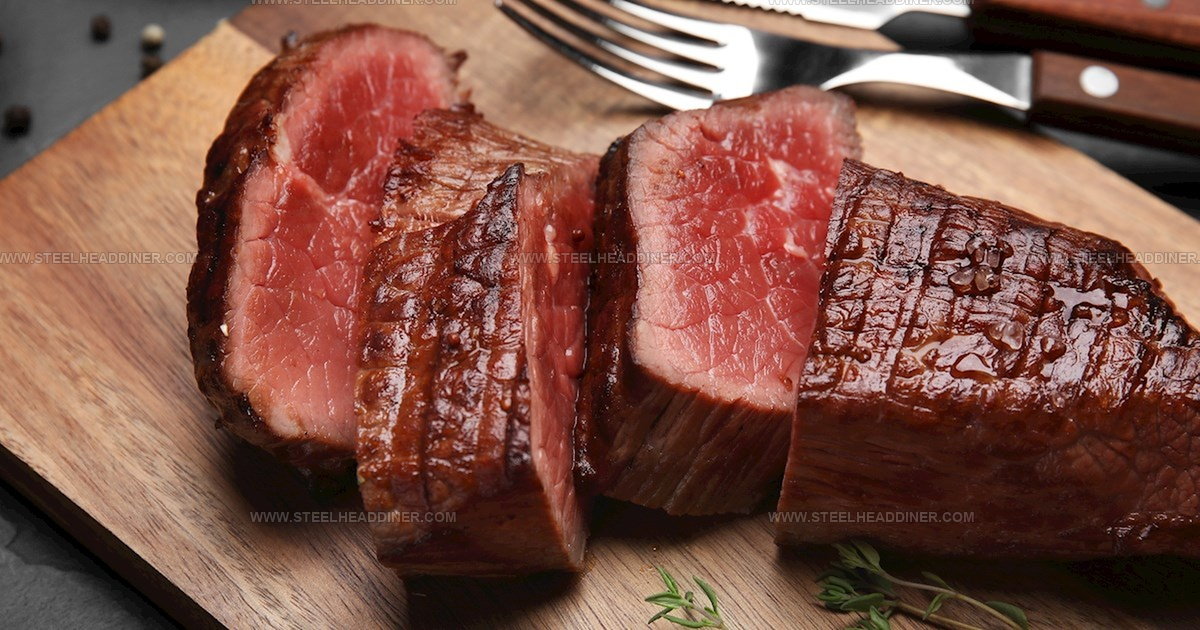
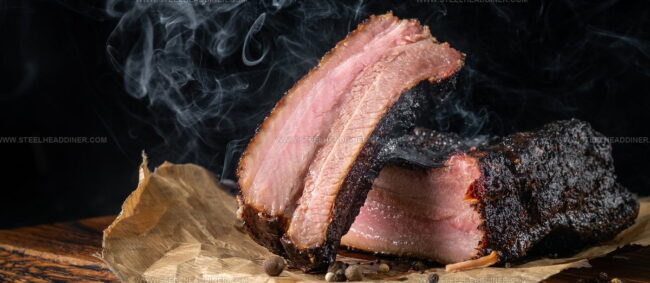
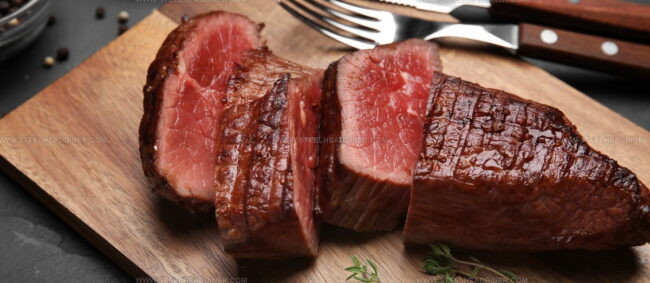
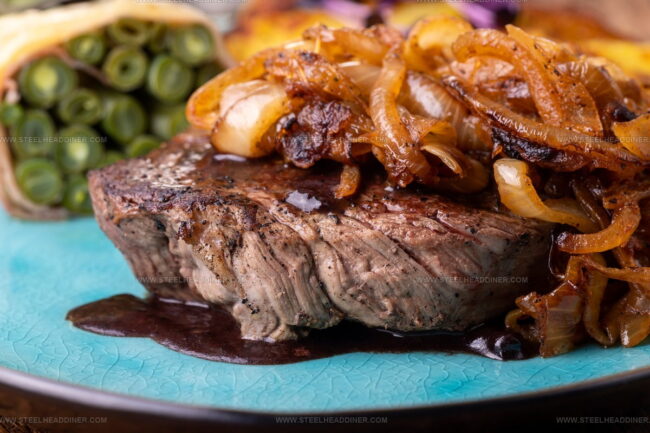
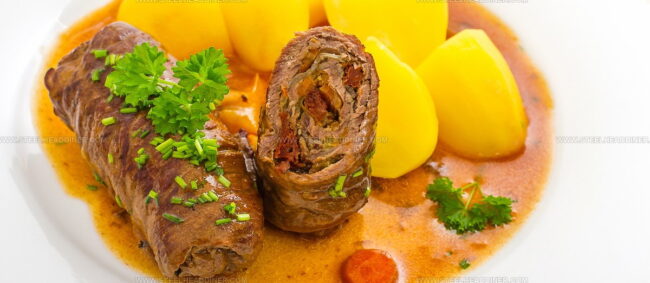
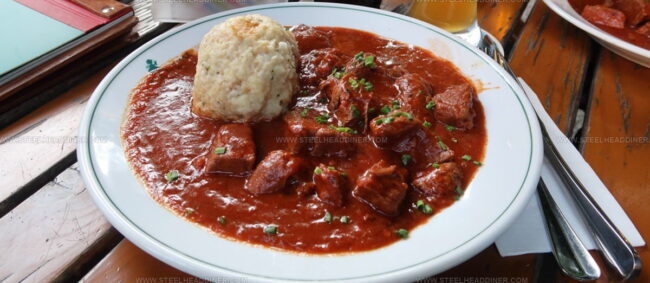
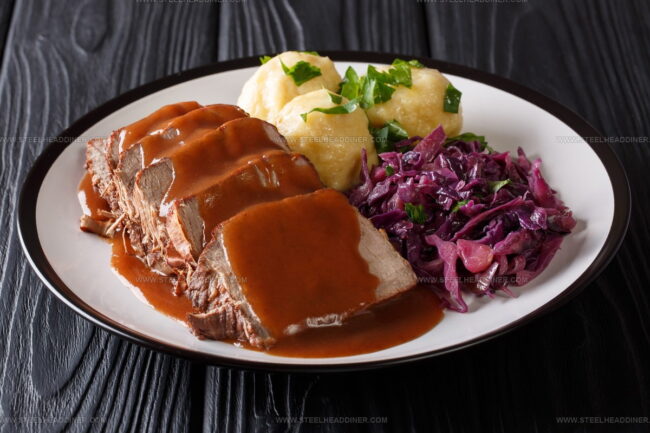
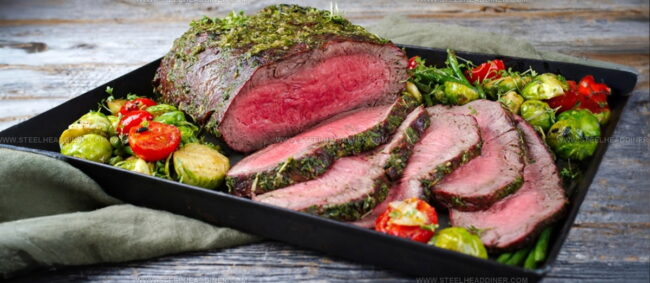
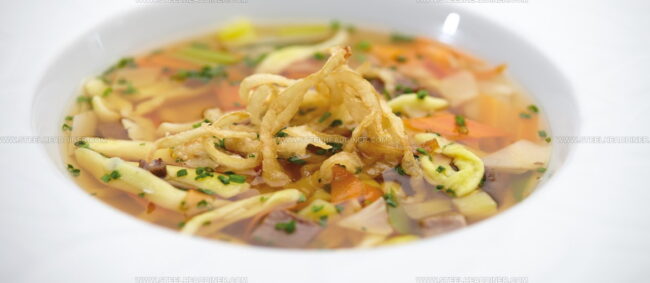
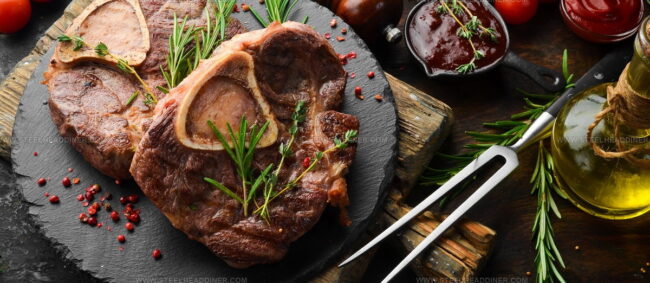
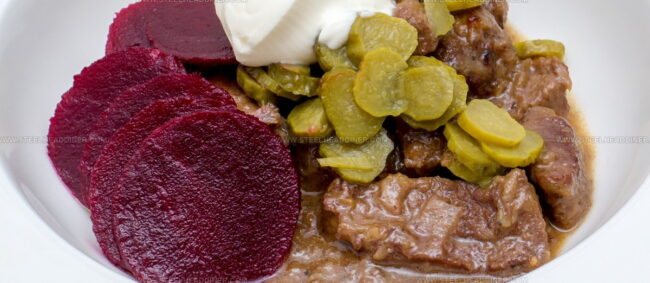
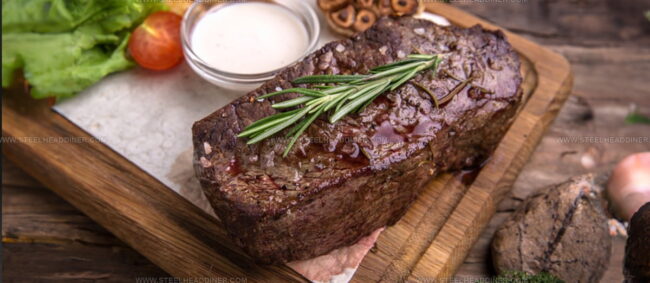
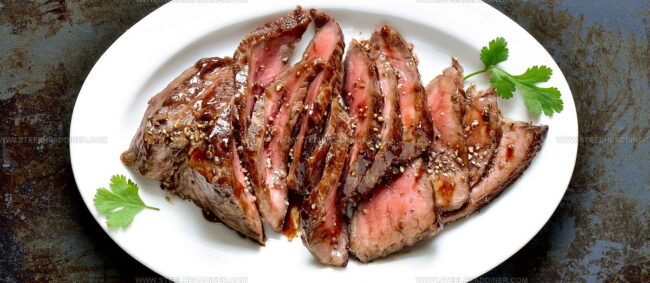
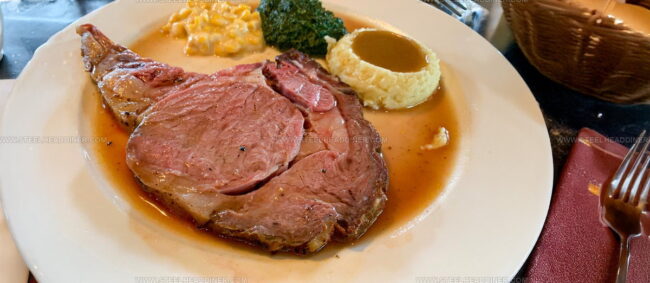
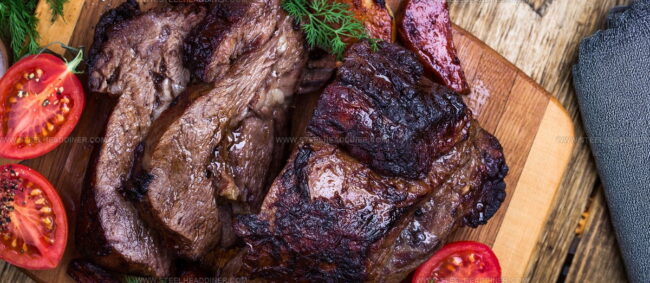
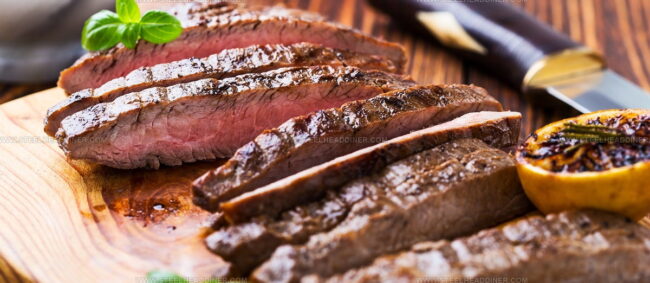

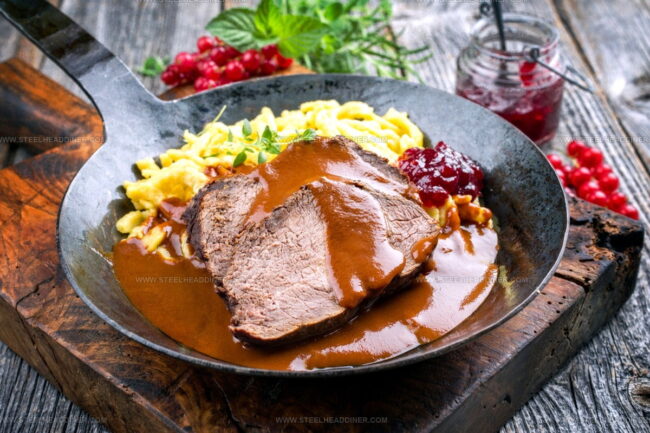
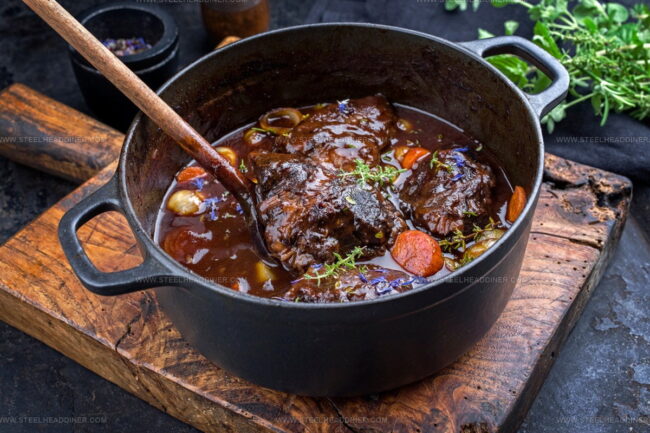
Jack Monroe
Founder & Recipe Innovator
Expertise
Pacific Northwest cuisine, Single-serving recipe development, Sustainable sourcing and cooking, Modern comfort food
Education
Brightwater
Associate of Applied Science in Culinary Arts
Focus: Sustainable cooking, seasonal ingredients, and food systems education
Jack grew up with a fishing rod in one hand and a cast-iron skillet in the other. After graduating from Brightwater: A Center for the Study of Food, he set out to prove that cooking for one could still taste like a feast.
Jack believes that food should feel real: fresh, fearless, and a little wild, just like the rivers he grew up around. For Jack, every single dish is a small adventure, and the best ones are the ones you can cook with heart, not hassle.